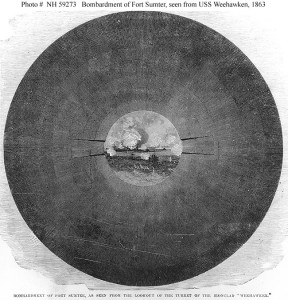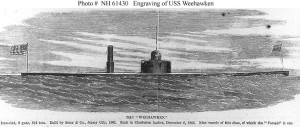I know the feeling. When I read current events, I’m aware I don’t have the energy to feel compassion for all the constant death and destruction around our world. Also, for the most part, I’m very analytic reading about that seemingly unending war 150 years ago and the hundreds of thousands of deaths. The following was a good reminder that the deaths hit home. And the description of the dead naval engineer reminded me of a neighbor that I looked up to in my youth. He died heroically in the Vietnam War.
The USS Weehawken sunk off Charleston on December 6, 1863. It did not sink during combat. About eight days later the uncertain became certain; the impersonal became personal.
From The New-York Times December 16, 1863:
Tribute to a Young Patriot.; HENRY W. MERIAN, OF THE IRON-CLAD WEEHAWKEN.
When the news reached this City that the Weehawken had gone down with four engineers and thirty of her crew, the cold, concise manner of the announcement may have caused it to be passed over with a casual sigh by many of our fellow-citizens; but in one home, how deep, how awful were those words! What a knell tolled in every heart as they were read, and the happy, peaceful home plunged in a moment into the deepest despair. Still, hope would live, and faint as the spark, it cheered, not only this sad family, but many sympathizing friends. Last night, however, this little light went out — heading the list of the lost was that dear name, the son, the brother, the friend, the true, noble young patriot.

said to be the”Bombardment of Fort Sumter, as seen from the Lookout of the Turret” of USS Weehawken. This may represent the 7 April 1863 attack on Fort Sumter.
Leaving a home surrounded by every comfort, a devoted father and loving sister; casting no fond, lingering look behind upon the hopes, the luxuries of life, HENRY W. MERIAN joined the enthusiastic ranks of our volunteer army, and did good service in those days of trial, the Spring of ’61. Educated as an engineer, and never having relinguished his desire to serve his country, young MERIAN, at a later period, joined the Weehawken, when she was preparing to leave this port, holding the post of Third Assistant Engineer — a post not worthy his talents and education, but which would most assuredly have been to him but a stepping-stone to higher fortunes had his young life been spared. Ever generous and forgetful of self, with a heart entirely devoted to his country, our young friend thought only of his duty, and took a manly part in all the dangers and difficulties that menaced the Weehawken on her perilous voyage south, and later off Charleston, when she planted the fatal shot in the magazine of Fort Moultrie, and was exposed to such danger herself. No fond entreaty from home could persuade him to leave his post while work was to be done; and in his last letter, possibly alluding to the different changes and promotions that had taken place, he wrote: “I stand by the Weehawken, sink or swim.” Alas! how soon was this sad alternative to be! Without a moment’s preparation, hurried from youth, life and hope, to vast eternity!
![[View from parapet of Fort Sumter, Sept. 8, 1863, showing Federal ironclads WEEHAWKEN, MONTAUK, and PASSAIC; taken by a Confederate photographer] (by George S. Cook, 1863, printed later; LOC: LC-USZ62-49549)](https://www.bluegrayreview.com/wp-content/uploads/2013/12/3a49652r-277x300.jpg)
I saw three ships come shelling us (View from parapet of Fort Sumter, Sept. 8, 1863, showing Federal ironclads WEEHAWKEN, MONTAUK, and PASSAIC; taken by a Confederate photographer)
Negligence has been imputed to the officers of the Weehawken, but knowing as we do the character and whole career of this fine young man, we feel assured that whatever responsibility rested on him was faithfully discharged. When uncertainty veiled the sad truth from his friends, it was said by those who knew him well: “Were his character less generous, we might have some hope.”
But though no voice may come from that watery grave to tell us his last words or deeds; no consolation be brought to his sorrowing family; we feel assured, that in dying, as in living, his heart was true to his God, his duty, and his country. E.
TUESDAY, Dec. 15.
It look like a Brooklyn paper published a poem to honor Henry W. Merian.
According to the Library of Congress the photo from Fort Sumter “is the first known Civil War combat photo taken with the photographer actually under fire.”
You can see much more of the Weehawken at the Navy

